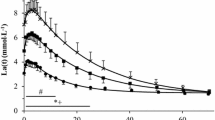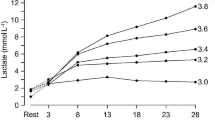Summary
The basal and exercise-induced heart rates, lactate levels, and the adrenaline and noradrenaline excretions in the urine were measured during different types of physical exercise and mental performance: during moderate physical exercise (Ia, n = 12), submaximal physical exercise (Ib, n = 24), during moderate mental performance (motorway driving, II a and II b, n = 25), higher-grade mental performance (driving car-simulator, III, n= 14), and during submaximal mental performance (car racing, IV, n = 48). The moderate physical exercise and moderate mental performance could not be differentiated from one another, or from the higher-grade mental performance using the above-mentioned parameters. Both the submaximal physical exercise and mental performance resulted in a comparable lactate acidosis, heart rate increase, and noradrenaline excretion; the excretion of adrenaline is, however, 3 times higher after submaximal mental performance, than after submaximal physical exercise. The ratio of adrenaline to noradrenaline excretion changed from approximately 1:4 (during physical exercise and moderate mental performance) to approximately 1:2 during submaximal mental performance. The excretion of adrenaline and the ratio of adrenaline to noradrenaline excretion can therefore be used to differentiate between higher-grade mental performance and physical exercise. These parameters can be easily measured without discomfort to the subjects.
Zusammenfassung
Die Herzfrequenz, der Lactatspiegel, die basale und belastungsbezogene Ausscheidung an freiem Adrenalin and Noradrenalin im Harn wurden bei leichtgradiger (Ia, n=12), bei submaximaler Körperarbeit (Ib, n=24), ferner während leichtgradiger (Autobahnfahrt, IIa and IIb, n=25), höhergradiger (Autosimulatorfahrt, III, n=14) and submaximaler konzentrativer Belastung (Motorrennsport, n=48, IV) bestimmt. Die leichtgradige körperliche und konzentrative Belastung können anhand dieser Größen weder untereinander noch gegenüber der höhergradigen konzentrativen Belastung abgegrenzt werden. Die submaximale körperliche und konzentrative Belastung führen zu einer vergleichbaren Lactatazidose, Herzfrequenz und Noradrenalinausscheidung, die Adrenalinausscheidung ist jedoch bei submaximaler konzentrativer Belastung im Mittel dreifach höher als bei submaximaler Körperarbeit. Das Verhältnis Adrenalin-zu Noradrenalinausscheidung ändert sich folglich von ca. 1:4 (Körperarbeit und leichtgradige konzentrative Belastung) auf ca. 1:2 während submaximaler konzentrativer Belastung. Die Adrenalinausscheidung und das Verhältnis der Adrenalin-zur Noradrenalinausscheidung können zur Beurteilung und Abgrenzung der konzentrativen, hohergradigen Belastung von der Körperarbeit beitragen. Diese Größen können einfach and ohne Beeinträchtigung des Probanden ermittelt werden.
Similar content being viewed by others
Literatur
Da Prada M, Zürcher G (1979) Radioenzymatic assay of plasma and urinary catecholamines in man and various animal species. Physiological and pharmacological applications. In: Radioimmunoassay of drugs and hormones in cardiovascular medicine. Elsevier North-Holland, Biochemical Press, pp 112–119
Edmondson D, Roscoe B, Vichers MD (1972) Biochemical evidence of anxiety in dental patients. Br Med J 4:7–9
Ekblom B, Kilbom A, Soltysiak J (1973) Physical training, bradycardia and autonomic nervous system. Scand J Clin Lab Invest 32:251–256
Euler US von (1972) Synthesis, uptake and storage of catecholamines in adrenergic nerves, the effect of drugs. In: Eichler O, Farah A, Herken H, Welch AD (eds) Handbook of experimental pharmacology, XXXIII. Springer, Berlin Heidelberg New York, pp 186–230
Euler US von (1974) Sympathoadrenal activity in physical exercise. Med Sci Sports 3:165–173
Galbo H, Hoist JJ, Christensen NJ (1975) Glucagon and plasma catecholamine response to graded and prolonged exercise in man. J Appl Physiol 38:70–76
Gossler K, Schiele R, Schaller KH, Weltle D, Miller S, Valentin H (1978) Das Verhalten einiger biochemischer Parameter bei der physischen Beanspruchung durch einen Langstreckenmarsch. Int Arch Occup Environ Health 41:103–115
Haggendal J, Hartley LH, Saltin B (1970) Arterial noradrenaline concentration during exercise in relation to the relative work levels. Scand J Clin Lab Invest 26:337–342
Hartley LH, Mason JW, Hogan RP, Jones LG, Kotchen TA, Mougey EH, Wherry FE, Pennington LL, Ricketts PT (1972) Multiple hormonal responses to graded exercise in relation to physical training. J Appl Physiol 33:602–606
Hohorst HJ (1962) L-(+)-Lactat. Bestimmung mit Lactatdehydrogenase and DPN. In: Bergmeyer HU (Hrsg) Methoden der enzymatischen Analyse. Verlag Chemie, Weinheim, S 266–277
Howley TE (1976) The effect of different intensities of exercise on the excretion of epinephrine and norepinephrine. Med Sci Sports 8:219–222
Keul J, Haralambie G (1973) Die Wirkung von Kohlenhydraten auf die Leitungsfähigkeit und die energieliefernden Substrate im Blut bei langwährender Körperarbeit. Dtsch Med Wochenschr 98:1806
Keul J (1975) Muscle metabolism during long-lasting exercise. In: Howald H, Poortmans JR (eds) Metabolic adaption to prolonged exercise. Birkhäuser, Basel, pp 31–42
Keul J, Lehmann M (1979) Psychophysische Reaktionen bei extremen Belastungen. Therapiewoche 29:4906–4922
Keul J, Lehmann M (1979) Emotionaler Streß beim Leistungssport. Monatskurse fur die ärztliche Fortbildung 29:325–328
Kindermann W, Simon G, Keul J (1978) Dauertraining — Ermittlung der optimalen Trainingsfrequenz und Leistungsfähigkeit. Leistungssport 8:34–39
Kindermann W, Schramm M, Keul J (1980) Performance diagnostics with different experimental settings. Int J Sports Med 1:110–114
Kindermann W, Schmitt WM, Biro G, Schnabel A (1981) Metabolismus and hormonelles Verhalten unter akuter Beta-I-Sympathikolyse. Z Kardiol 70:406–412
Laverty R, Taylor KM (1968) The fluorometry of catecholamines and related compounds. Anal Biochem 22:260–279
Lehmann M, Keul J, Schmid P, Kindermann W, Huber G (1980) Plasmacatecholamine, Glucose, Lactat sowie aerobe und anaerobe Kapazität bei Jugendlichen. Dtsch Z Sportmed 31:287–295
Lehmann M, Keul J (1980) Katecholaminausscheidung und Katecholaminblutspiegel bei verschiedenen Belastungen. In: Nowacki PE, Böhmer D (Hrsg) Sportmedizin, Aufgaben und Bedeutung fur den Menschen in unserer Zeit. Thieme, Stuttgart New York, S 99–103
Lehmann M, Keul J, Huber G, Bachl N, Simon G (1981) Alters- und belastungsbedingtes Verhalten der Plasmacatecholamine. Klin Wochenschr 59:19–25
Lehmann M, Keul J, Wybitul K (1981) Einfluß einer stufenweisen Laufband- und Fahrradergometrie auf die Plasmacatecholamine, energiereichen Substrate, aerobe und anaerobe Kapazität. Klin Wochenschr 59:553–559
Lehmann M, Keul J, Korsten-Reck U, Fischer H (1981) Einfluß der Ergometerarbeit im Liegen und Sitzen auf Plasma catecholamine, metabolische Substrate sowie Sauerstoffaufnahme und Herzfrequenz. Klin Wochenschr 59:1237–1242
Lehmann M, Keul J, Huber G, Da Prada M (1981) Plasma catecholamines in trained and untrained volunteers during graduated exercise. Int J Sports Medicine 2:143–147
Robinson BF, Epstein SE, Beiser GD, Braunwald E (1966) Control of heart rate by the autonomic nervous system. Circ Res 19:400–411
Schiele R, Goßler K, Schaller KH (1978) Untersuchungen zum Verhalten verschiedener beanspruchungsbezogener biologischer Parameter unter definierten physischen und psychischen Belastungen. Bundesanstalt fur Arbeitsschutz und Unfallforschung Dortmund (Hrsg). Wirtschaftsverlag, Bremerhaven, S 45–50
Taggert P, Carruthers M, Sommerville W (1973) Electrocardiogram, plasma catecholamines and lipids, and their modification by oxprenolol when speaking before an audience. Lancet I:341–346
Timio M, Gentili S, Pede S (1979) Free adrenaline and noradrenaline excretion related to occupational stress. Br Heart J 42:471–474
Author information
Authors and Affiliations
Additional information
Mit Unterstützung des Bundesinstitutes fur Sportwissenschaft, Köln-Lövenich
Herrn Prof. Dr. med. Dr. h.c. mult. G. Schettler zum 65. Geburtstag gewidmet
Rights and permissions
About this article
Cite this article
Lehmann, M., Huber, G., Spöri, M. et al. Katecholaminausscheidung bei körperlichen und konzentrativen Belastungen. Int. Arch Occup Environ Heath 50, 175–186 (1982). https://doi.org/10.1007/BF00378079
Received:
Accepted:
Issue Date:
DOI: https://doi.org/10.1007/BF00378079




